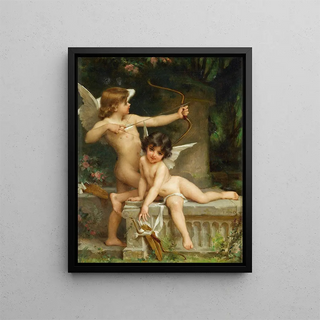Art print | Two Loves - Émile Munier


View from behind

Frame (optional)
In the vast panorama of art history, certain works stand out for their ability to capture the very essence of human emotions. "Deux Amours" by Émile Munier is one of those creations that transcends the simple frame of painting to offer an unforgettable visual and emotional experience. This piece, both delicate and powerful, evokes a dialogue between love and tenderness, revealing the artist's mastery in depicting feelings. Through this art print, the viewer is invited to immerse themselves in a universe where beauty and emotion meet, creating an intimate connection with the artwork.
Style and uniqueness of the piece
The painting "Deux Amours" is characterized by its realistic style, typical of the late 19th century, a period during which Émile Munier established himself as a master of depicting human figures. The work is distinguished by its palette of soft and warm colors, which evoke an atmosphere of serenity and gentleness. The faces of the two young loves, imbued with touching innocence, are carefully detailed, while the drapery of their clothing adds a dimension of lightness and movement. Munier manages to capture moments of life, delicate gestures, and subtle expressions that tell a story without words. This realism, combined with artistic sensitivity, makes "Deux Amours" an emblematic work of its time, while remaining timeless.
The artist and his influence
Émile Munier, born in 1840, made his mark on his era with his exceptional talent and his ability to evoke human emotions through his works. Trained at the École des beaux-arts in Paris, he drew inspiration from past masters while developing a style that was uniquely his own. His work is often associated with themes of daily life, love, and family, giving it a universal dimension. Munier influenced many contemporary artists and left a lasting imprint on the art world. His ability to fuse technique and emotion made him an essential figure in the realist movement, and "Deux Amours" is a perfect example. The artist manages

Matte finish

View from behind

Frame (optional)
In the vast panorama of art history, certain works stand out for their ability to capture the very essence of human emotions. "Deux Amours" by Émile Munier is one of those creations that transcends the simple frame of painting to offer an unforgettable visual and emotional experience. This piece, both delicate and powerful, evokes a dialogue between love and tenderness, revealing the artist's mastery in depicting feelings. Through this art print, the viewer is invited to immerse themselves in a universe where beauty and emotion meet, creating an intimate connection with the artwork.
Style and uniqueness of the piece
The painting "Deux Amours" is characterized by its realistic style, typical of the late 19th century, a period during which Émile Munier established himself as a master of depicting human figures. The work is distinguished by its palette of soft and warm colors, which evoke an atmosphere of serenity and gentleness. The faces of the two young loves, imbued with touching innocence, are carefully detailed, while the drapery of their clothing adds a dimension of lightness and movement. Munier manages to capture moments of life, delicate gestures, and subtle expressions that tell a story without words. This realism, combined with artistic sensitivity, makes "Deux Amours" an emblematic work of its time, while remaining timeless.
The artist and his influence
Émile Munier, born in 1840, made his mark on his era with his exceptional talent and his ability to evoke human emotions through his works. Trained at the École des beaux-arts in Paris, he drew inspiration from past masters while developing a style that was uniquely his own. His work is often associated with themes of daily life, love, and family, giving it a universal dimension. Munier influenced many contemporary artists and left a lasting imprint on the art world. His ability to fuse technique and emotion made him an essential figure in the realist movement, and "Deux Amours" is a perfect example. The artist manages






